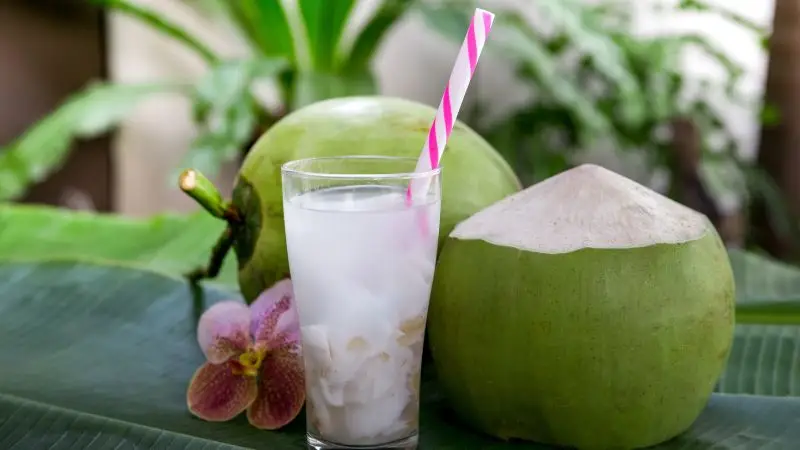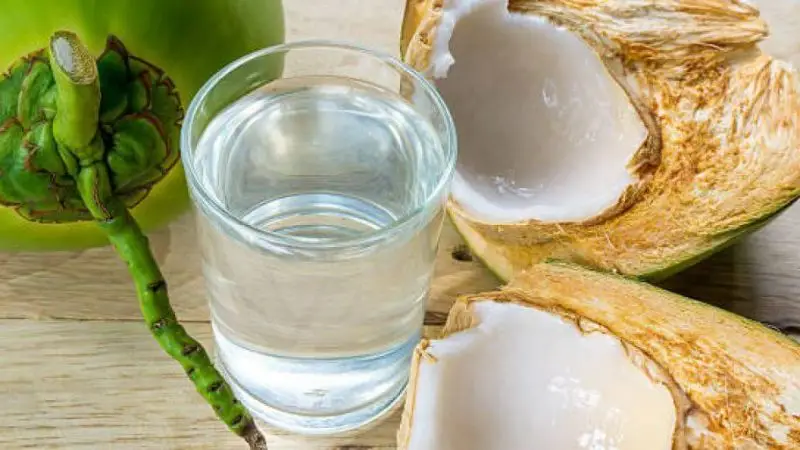In the realm of natural beverages, coconut water stands out as a hydrating and delicious choice. It’s not only a tropical delight but also a powerhouse of nutrients. Ever wondered if you could make coconut water at home, ensuring freshness and authenticity? This DIY guide will take you through the step-by-step process of crafting your own coconut water without any artificial additives.
Must Read: What Does Coconut Milk Taste Like?
Selecting the Right Coconut
Before diving into the process of making coconut water, it’s crucial to start with the right coconut. Opt for coconuts that are heavy for their size, indicating a high water content. The husk should be free from mold or soft spots, ensuring the freshness of the coconut water inside. Shake the coconut; a sloshing sound indicates liquid, a sign that it’s ready for harvesting.

Tools You’ll Need
Making coconut water at home is a straightforward process, and you won’t need an extensive list of tools. Here’s what you’ll need:
- Coconut
- 1-2 fresh coconuts
- Cleaver or Machete
- To crack open the coconut
- Blender
- To extract the coconut water
- Strainer or Cheesecloth
- To remove coconut bits
- Bowl or Pitcher
- For collecting the coconut water
Now, let’s get started with the step-by-step process.
Step 1: Crack Open the Coconut
Using a cleaver or machete, carefully crack open the coconut. Start by locating the three “eyes” on one end of the coconut. Use a screwdriver or a similar tool to puncture one of the eyes, creating a hole. Drain the coconut water into a bowl or pitcher.
Next, turn the coconut so that the eyes are facing downward and firmly tap it with the back of the cleaver or machete. Rotate the coconut and continue tapping until it cracks open. Be cautious during this step to avoid injury.
Step 2: Extract the Coconut Water
Once the coconut is open, pour the collected coconut water into a blender. Now, carefully scoop out the coconut meat using a spoon or a coconut scraper. Add the coconut meat to the blender with the water.
Blend the mixture on high speed for about 2-3 minutes until it forms a smooth, milky liquid. The blending process ensures that the coconut water is infused with the natural sweetness and flavor of the coconut meat.
Step 3: Strain the Coconut Water
To achieve clear and smooth coconut water, strain the blended mixture using a fine mesh strainer or cheesecloth. This step removes any coconut bits or pulp, leaving you with pure coconut water. Gently press the coconut pulp in the strainer to extract as much liquid as possible.
Step 4: Store and Chill
Transfer the strained coconut water to a clean bowl or pitcher. For optimal freshness, refrigerate the coconut water for at least an hour before serving. This step enhances the natural coolness of coconut water, making it a refreshing beverage, especially on a warm day.
Step 5: Optional Additions
While pure coconut water is delightful on its own, feel free to get creative with optional additions. Add a splash of lime juice for a citrusy twist or a hint of agave syrup for a touch of sweetness. Experiment with mint leaves or a splash of pineapple juice for an extra tropical kick.
Step 6: Enjoy Your Homemade Coconut Water
It’s now time to enjoy your handmade coconut water. Pour it over ice, sip it straight from a chilled glass, or use it as a base for tropical cocktails. The satisfaction of crafting your coconut water from scratch adds an extra layer of enjoyment to every sip.
Benefits of Homemade Coconut Water
Crafting your coconut water at home comes with its own set of benefits:
- No Additives: Homemade coconut water is free from preservatives, sugars, or artificial flavors, ensuring a natural and pure taste.
- Cost-Effective: Making coconut water at home can be more cost-effective than purchasing pre-packaged versions, especially if you have a ready supply of fresh coconuts.
- Customization: You have full control over the flavor and sweetness of your coconut water. Try out several iterations to discover the ideal combination.
- Reduced Environmental Impact: By using fresh coconuts, you reduce the need for packaging and transportation associated with store-bought coconut water, contributing to a smaller carbon footprint.
Conclusion
Crafting coconut water at home is a rewarding experience that allows you to enjoy the pure, natural flavors of this tropical beverage. With just a few simple tools and a fresh coconut, you can create a refreshing drink that’s not only hydrating but also rich in nutrients.
Experiment with different coconut varieties, explore flavor combinations and make your coconut water a personalized delight. Embrace the simplicity and authenticity of homemade coconut water, and savor the taste of the tropics in every sip.
FAQs
- Can I use packaged coconut meat to make coconut water?
While fresh coconut meat is recommended for the best flavor, you can use packaged coconut meat as a convenient alternative. - How long can homemade coconut water be stored?
Homemade coconut water is best enjoyed fresh, but if stored in a sealed container in the refrigerator, it can last for up to 2-3 days. - Can I add sugar to sweeten the coconut water?
If you prefer a sweeter taste, consider adding natural sweeteners like agave syrup or honey instead of refined sugar for a healthier option. - What are some creative ways to use homemade coconut water?
Besides drinking it on its own, you can use homemade coconut water as a base for smoothies, and popsicles, or even as a substitute for water in baking recipes. - Is coconut water suitable for all diets?
Coconut water is naturally gluten-free, dairy-free, and vegan, making it suitable for various dietary preferences. However, individuals with nut allergies should exercise caution and consult with a healthcare professional if unsure.

